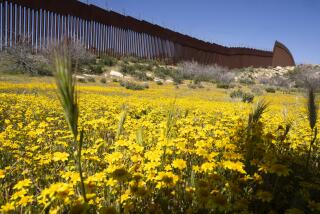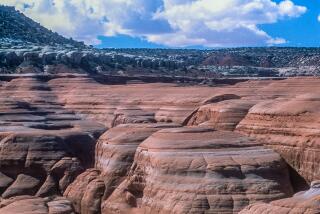Bioregionalism : A New Concept That Overtakes Environmentalism
- Share via
Radical environmental politics has a certain cachet in the city. If you work in a skyscraper, far removed from the earth, what could be cooler than to flaunt the Earth First! monkey wrench decal on your word processor, or to discuss over lunch the Gaia theory--which maintains the planet is a living organism.
So for those who are looking to pump up their portfolios with The Next Big Thing in Green politics, it’s here: bioregionalism, the movement that preaches “ ‘tis nobler to stay home than to land a better job in another city.”
The movement isn’t well known in Los Angeles yet, according to Peter Berg, who operates a bioregional clearinghouse in San Francisco. But bioregionalists are flourishing in the northernmost reaches of California, the high plains of Wyoming, the Missouri Ozarks, Arizona’s Sonoran desert and other areas where pavement hasn’t erased the landscape.
Kirkpatrick Sale, a leading bioregional theorist, describes a bioregion (it means life region ) as an area “governed by nature, not legislature.” By getting to know their immediate bioregions, Sale said, bioregionalists come to understand environmental problems on a personal scale.
He asserts that people who stay close to home ultimately protect the environment because it behooves them to do so.
There are more than 100 bioregional groups and publications around the country, according to Berg. Several bioregional thinkers continue to churn out thousands of words defining bioregionalism and bioregionalists. (One possible criteria for the latter: Can you give directions to your home without using human-made landmarks?)
The philosophy has even matured enough to have spawned detractors. “A bioregionalist is someone who travels around the world telling people to stay home,” is one bit of criticism in circulation.
Twentynine Palms bioregionalist Jane Grunt interprets bioregionalism as “being in love with your space.”
Grunt, who has lived in the California desert since she was a child, calls herself a bioregionalist because she has no desire to be anyplace else but home. (Her husband, Ron, however, confesses to missing the sea on occasion.)
People’s loss of identification with a specific place concerns bio-regionalists, Berg said. “We’re a move-on civilization.”
To Berg’s way of thinking, moving on usually means neglect for the place that is left behind. Berg explained that people like Grunt, who sink roots, are likely to have the attitude: “I intend to remain here and I don’t want someone to destroy the place for some silly, shortsighted gain.”
So if most of the population adopts bioregionalism--as some people predict it will--the environmental crisis will be solved, and a movement with what Sale admits is a clumsy name will have saved the planet.
Saving the Earth may sound like old-fashioned environmentalism to some, but Berg said bioregionalism encompasses far more than environmentalism. In fact, the new movement is discomfiting to old-school environmentalists who think their role is to keep people from throwing litter on the sidewalk, he said.
Sale, who lives for part of the year in New York City, agrees: “What we’re talking about here is not environmentalists tinkering with this or that to save a species; we’re talking about a fundamental reorganization of American society so that the values of nature become paramount. For bioregionalism to be established, the political and economic institutions of the country would have to be entirely altered.”
Concept Takes Hold
The first bioregional theorists began speaking out about 1977. The concept has since taken hold mostly in rural and semi-rural areas; but bioregionalists believe there’s room for the concept in the city too.
In San Francisco, Berg has been busy tearing out the sidewalk outside his office and sowing plants, “so the seeds can blow down the street and crack open all the sidewalks with native plants.”
He’s trying, where possible, to restore the habitat that once existed where his office is today. For instance, under his building is an old creek bed that comes to life in the rainy season, filling the basement with water. Instead of stopping the leak, Berg is considering opening up the basement floor so the creek can reclaim its rightful bed.
So popular is bioregionalism in Northern California that Berg predicts that some Northern California sectors will eventually “go bioregional,” dividing the area and electing officials according to bioregions, not counties.
In Berg’s vision, someday departments of bioregions will replace state governments. Existing borders will be disregarded because they interfere with natural bioregions. The Great Lakes Bioregional Conference already ignores the U.S.-Canada border, Berg said.
To determine a bioregion, one simply identifies the natural features that define the home or neighborhood. The features might be hills or gullies, watershed demarcations, a special plant or animal species, or even a dominant psychological or social influence such as a great mountain peak or a body of water. An imaginary line around the area delineated by natural features establishes a bioregion.
Once mapped out, the next task is to get to know “the bird songs and waterfalls and animal droppings” of the bioregion, according to Sale in his Sierra Club book, “Dwellers in the Land: The Bioregional Vision.” “Follow a brooklet to a stream and down to a river, and learn when to set out tomatoes, what kind of soil is best for celery and where blueberries thrive.”
In Ron and Jane Grunt’s case, they claim as their bioregion the Morongo Basin, a 40-mile strip of desert bordered by a Marine base on one side and Joshua Tree National Monument on the other.
To show how well she knows her bioregion, Jane Grunt recently proved able to answer every one of 20 questions on a popular bioregional quiz. How long is the growing season where you live? (Year-round.) Where does your garbage go ? (To the compost heap.) They’re the kinds of questions most city dwellers--disassociated from the place they live--would have a difficult time answering.
The Grunts are by no means environmental purists. On their property, they operate a combination bar-restaurant and a hotel called the 29 Palms Inn, a funky getaway for Hollywood types.
But the Grunts quietly carry on in bioregional fashion, despite a certain amount of incomprehension on the part of visitors. They study the local Indian lore and bake in an outdoor earthen oven like indigenous people once used to do here.
Among the artichokes and melons in their garden stands this wooden sign:
This isn’t the last place
There is everywhere else to go
This isn’t the last place
There is nowhere else we need to be.
Jane Grunt, a 45-year-old mother of five children from 5 to 25, said most people move so often they aren’t able or willing to incorporate knowledge of a place as a meaningful part of their lives.
“But that’s how you love something,” she said. “You have to get to know it to love it.”
A BIOREGIONAL QUIZ This is a self-scoring test on basic environmental perception of place. It favors people who live in the country over city dwellers, and scores can be adjusted accordingly. Most questions, however, are of such a basic nature that undue allowances are not necessary.
Many questions have different correct answers, depending on where one lives.
1. Trace the water you drink from precipitation to tap.
2. How many days until the moon is full? (Slack of two days is allowed.)
3. What soil series are you standing on?
4. What was the total rainfall in your area last year (July through June) (Slack of one inch for every 20 inches permitted.)
5. When was the last time a fire burned your area?
6. What were the primary subsistence techniques of the culture that lived in your area before you?
7. Name five native edible plants in your region and their season(s) of availability.
8. From what direction do winter storms generally come in your region?
9. Where does your garbage go?
10. How long is the growing season where you live?
11. On what day of the year are the shadows the shortest where you live?
12. When do the deer rut in your region, and when are the young born?
13. Name five grasses in your area. Are any of them native?
14. Name five resident and five migratory birds in your area.
15. What is the land-use history where you live?
16. What primary geological event/process influenced the land form where you live? (Bonus special: What’s the evidence?)
17. What species have become extinct in your area?
18. What are the major plant associations in your region?
19. From where you’re reading this, point north.
20. What spring wildflower is consistently among the first to bloom where you live?
SCORING:
0-3 You have your head in a hole.
4-7 It’s hard to be in two places at once when you’re not anywhere at all.
8-12 A fairly firm grasp of the obvious.
13-16 You’re paying attention.
17-19 You know where you’re at.
20 You not only know where you’re at, you know where it’s at.
Used with permission of the authors, Leonard Charles, Jim Dodge, Lynn Milliman and Victoria Stockley. The quiz was first published in the Whole Earth Review.
More to Read
Sign up for Essential California
The most important California stories and recommendations in your inbox every morning.
You may occasionally receive promotional content from the Los Angeles Times.













